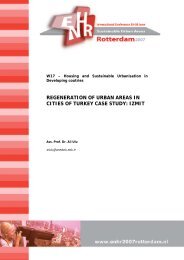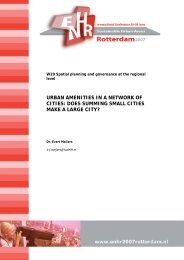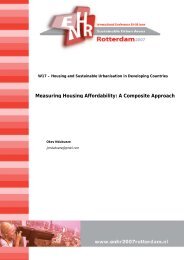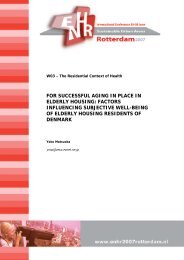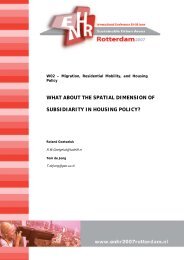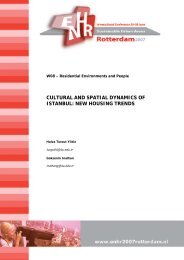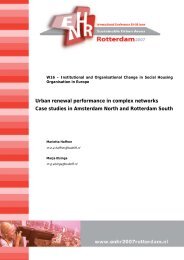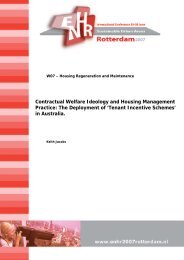The new Dutch Land development Act as a tool for value capturing
The new Dutch Land development Act as a tool for value capturing
The new Dutch Land development Act as a tool for value capturing
Create successful ePaper yourself
Turn your PDF publications into a flip-book with our unique Google optimized e-Paper software.
<strong>The</strong> <strong>new</strong> <strong>Dutch</strong> <strong>Land</strong> <strong>development</strong> <strong>Act</strong> <strong>as</strong> a <strong>tool</strong> <strong>for</strong> <strong>value</strong> <strong>capturing</strong><br />
- <strong>The</strong> costs <strong>for</strong> compensation of the damage caused by planning<br />
- <strong>The</strong> costs of interest (including the costs of temporarily exploitation of the area –<br />
taking possible profits into account)<br />
- <strong>The</strong> costs <strong>for</strong> acquiring the land (e.g. the <strong>value</strong> of the land).<br />
As far <strong>as</strong> the costs <strong>for</strong> public facilities are concerned, the order indicates which kind of public<br />
facilities can be taken into account:<br />
- Public amenities <strong>as</strong> far <strong>as</strong> the costs are paid by the municipality and are not adjusted in<br />
the normal charges<br />
- Sewerage system<br />
- Roads, parking facilities in the “open air”, other investments in the public space, and<br />
costs of the water system<br />
- Infr<strong>as</strong>tructure <strong>for</strong> public transport facilities, <strong>as</strong> far <strong>as</strong> these are not adjusted in the<br />
normal charges<br />
- Green are<strong>as</strong> (parks, playing grounds, nature are<strong>as</strong>)<br />
- Streetlights and fireplugs<br />
- Street furniture, fences, etc.<br />
- Build up parking facilities, <strong>as</strong> far <strong>as</strong> these lead to optimizing the land use in the area<br />
and the improvement of the quality of the public space and are mainly used by the<br />
inhabitants and the users of the area, <strong>as</strong> far <strong>as</strong> the costs are paid by the municipality<br />
and are not adjusted in the normal charges<br />
- In the interest of environmental protection, archaeological or public health necessary<br />
facilities.<br />
Besides the limitation of the type of costs that can be recovered, another limitation is in which<br />
extent these costs can be recovered.<br />
<strong>The</strong> <strong>Act</strong> introduces three criterions, which are applied cumulative:<br />
- Profit: only costs <strong>for</strong> me<strong>as</strong>ures of which the area of part of the area profits can be<br />
recovered.<br />
For example, if outside the area a subway is realised without any station nearby, the<br />
costs cannot be recovered.<br />
- Causality: only if the me<strong>as</strong>ures are in some way connected to the project, the costs can<br />
be recovered. For example, if the municipality tries to recover costs <strong>for</strong> an “old<br />
project” these cannot be recovered<br />
- Proportionality: if the me<strong>as</strong>ures are also profitable <strong>for</strong> other persons, the costs can only<br />
be recovered proportionally.<br />
For example, if surrounding are<strong>as</strong> without a park will also use the park that is realised<br />
in the <strong>new</strong> urban area, the costs can only partly be recovered.<br />
Besides these three criterions, also a fourth one should be taken into account. <strong>The</strong> costs can<br />
only be recovered to what is financial fe<strong>as</strong>ible within the project. So if the costs the<br />
municipality wants to recover exceed the profits <strong>for</strong> the developers, the possibilities <strong>for</strong> cost<br />
recovery are limited.<br />
In Parliament, there w<strong>as</strong> some discussion whether a more general payment <strong>for</strong> certain costs<br />
outside the area to be developed could be introduced. An amendment h<strong>as</strong> been approved,<br />
which makes it possible that cost recovery takes place <strong>as</strong> a contribution to a fund. However,<br />
the strategic plan <strong>for</strong> the area (structuurvisie) should indicate <strong>for</strong> which kind of projects the<br />
fund would be used. And also the above-mentioned criterions apply.<br />
Workshop: Legal Aspects of Housing, <strong>Land</strong> and Planning<br />
Author: Herman de Wolff<br />
9



